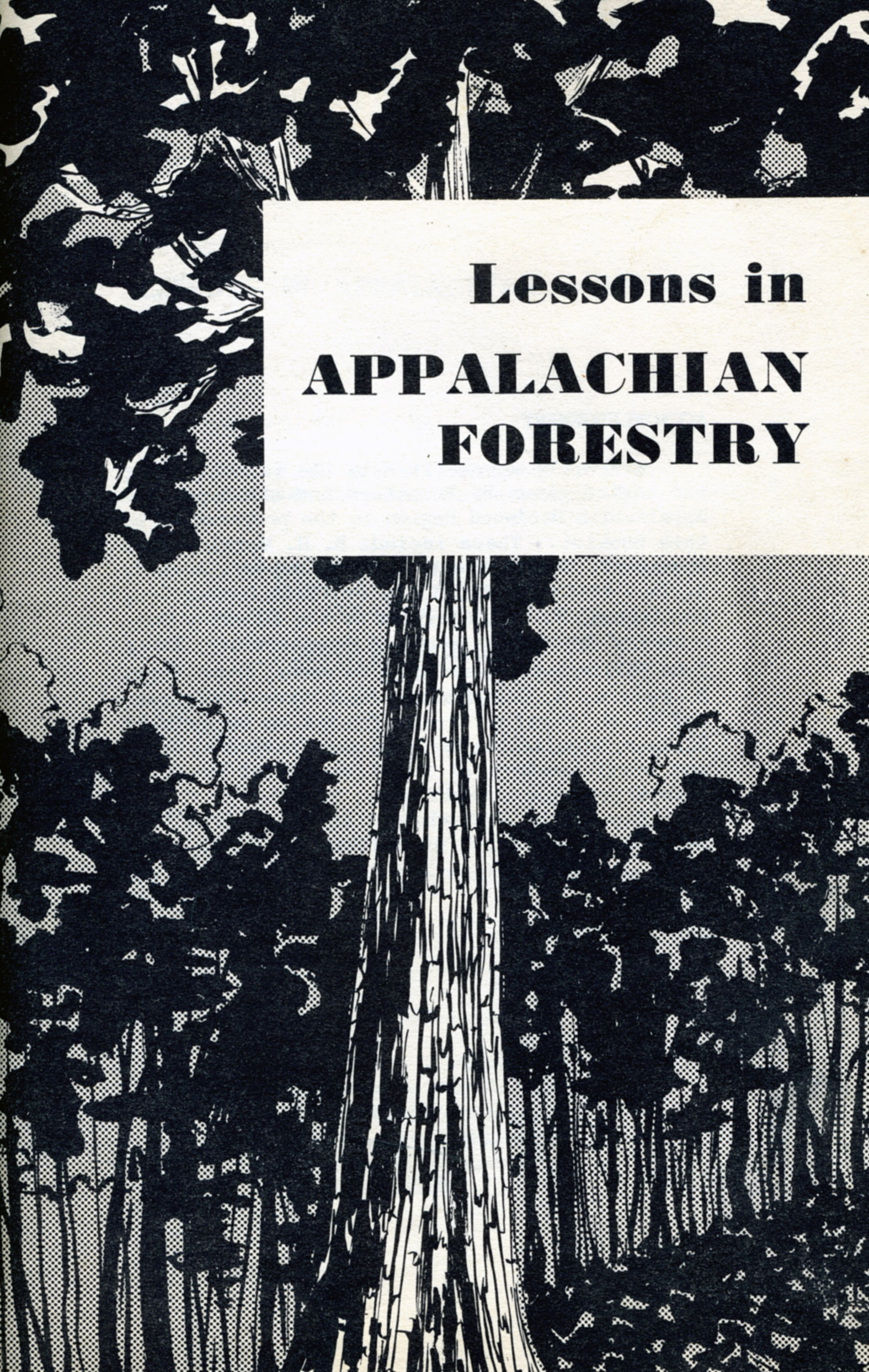|
Page |
Image |
Description |
Thumbnail |
| Cover |
app_
0001 |
Lessons in
Appalachian Forestry |
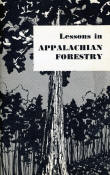 |
| Inside front cover |
0002 |
ACKNOWLEDGEMENT
Sincerely appreciated is the valuable
help and advice given by foresters and others in the Appalachian
Hardwood Region in the preparation of this booklet. These include R.
H. Morris, Vice President, Gauley Mountain Coal Company, Ansted, W.
Va.; Luther 0. Griffith, Griffith Lumber Co., Huntington, W. Va.,
Chairman of the Forestry Committee of Appalachian Hardwood
Manufacturers, Inc.; John Tillinghast, Consulting Forester, Mount
Hope, W. Va.; C. H. Clendening, Secretary-Treasurer, and H. E.
Everley, Trade Extension Department Manager, Appalachian Hardwood
Manufacturers, Inc.; and staff members of American Forest Products
Industries, Inc., Washington, D. C.
Especially acknowledged is the work of
Miss Adele Alice Griffith of Huntington, W. Va., who
prepared the drawings and illustrations
for the text.
|
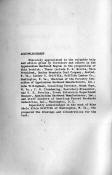 |
| Title page |
0003 |
LESSONS
IN APPALACHIAN FORESTRY
By
H. D.
BENNETT, Forester
Appalachian Hardwood Manufacturers, Inc.
Illustrations by
ADELE ALICE GRIFFITH
Published by
Forestry
Division
Appalachian Hardwood Manufacturers, Inc.
414 Walnut Street
Cincinnati, Ohio
1950 |
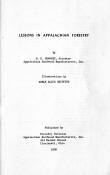 |
| Foreword |
0004 |
FOREWORD
Many books, bulletins and pamphlets have
been written concerning forestry in the United States. Their use in
schools has usually been dependent upon the teacher having had a
course in forestry or conservation in order to present it to the
students. This booklet is an attempt to give to the teacher and to
the student in plain, non-technical language, a step-by-step story
of the forests, forestry and logging, and their relation to the
people of the Appalachian Hardwood Region.
In the Appalachian Hardwood Region we
are becoming increasingly aware of the economic importance of our
forests. The extensive lumber operations are dependent upon good
timber for their source of raw material. While much of the economy
of the country is based on the production of coal, an adequate
timber supply for props, headers, ties and other material is
essential to maintain this important industry.
In the following pages of this booklet
is a brief and concise picture of forestry and our forests. Through
study of its pages we can picture the forests of the past and the
problems of the early loggers, as well as the new forest economy
with which we are confronted today. With our frontiers gone and our
second-growth stands of timber before us, we are growing these trees
for use through adequate fire control, proper cutting practices, and
proper utilization. I am sure that through the reading of this book,
teachers and students alike will obtain an enlightened view of the
importance of our forests in our everyday lives and the problems
before us in maintaining a productive stand of trees.
I hope that this booklet will find an
important place in the school curricula. The school children of
today are the ones who will manage our timber stands of tomorrow. A
basic understanding of the timber stands and wood needs of the
region will help them to guide the destiny of these forests along a
sound course.
—H. D. Bennett
|
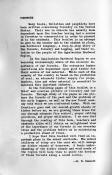 |
| Table of contents |
0005 |
TABLE OF CONTENTS
1. Forests - Past, Present and Future 6
2. Forests and Our Daily Lives 10
3. The Growth of Trees 15
4. Important Trees of the Appalachian
Hardwood Region 19
5. Products of the Forest 26
6. Care of Our Forests 30
7. Animals of the Forest 33
8. Trees - Floods, Soil and Climate 36
9. Forest Enemies 39
10. Forest Guardians 42
11. Looking to
the Future 46
|
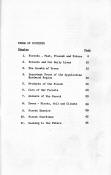 |
Chapter 1
page 6 |
0006 |
Chapter One
FORESTS — PAST, PRESENT AND FUTURE
In writing the history of lumbering in
America it is hard to agree just where and when it began, but there
is one point that is proven: the harvesting of trees is the oldest
business in America. The first form of trade between America and
Europe was in forest products.
History relates that shortly before the
year 1000, a hardy race of sailors and explorers known as the
Vikings, or Norsemen, sailed over the sea to Greenland, where they
established a colony. Greenland had no trees, so a group of these
explorers, under Leif Ericson, sailed westward in search of timber.
They needed wood to build their homes, repair their ships and
furnish fuel for heat. They finally came to the shores of what is
now labrador. There they found trees growing. They cut some of the
timber and loaded it on their ships and carried it to Greenland.
The following year, the men returned and
set up a logging camp. Then for many years they furnished the
colonies on Greenland with the products of these forests. On later
voyages, it is said, the Norsemen came as far south as New England
and returned with cargoes of forest products.
In those early days, forests covered
about one-half of what is now the United States. They stretched from
Maine to Florida and across the country as far as the Great Plains.
Most of the Great Plains was grassland, with trees growing only
along some of the stream banks. Near the Rocky Mountains another
area of timberland stretched from Canada south to Mexico and west to
the Pacific Ocean.
Many explorers and settlers came to the
shores of the New World. Some sought riches in gold, spices and
timber, and others came to find freedom and to establish homes. On
this frontier, as on every timber frontier, the settler took from
the great forest the wood he needed to build his house, furniture,
fences, and for his other needs. And, like the Indians with whom he
shared the land, he hunted for food in the shade of the forest.
The timber found along the coastal plain
could be sold in England. Oak was needed for building English ships,
and the "King's Broad Arrow" became
6
|
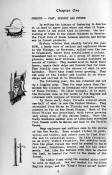 |
| 7 |
0007 |
a familiar mark on the tall pine trees
picked for masts. Trees so marked could not be cut for any other
purpose. The sale of this timber was a great help to the struggling
settler.
Although the forest was the settler's
friend, it was also his enemy. He had to fight the stubborn trees,
burning and chopping clearings in which to grow his crops. As more
settlers came into the country and the demand for food and farm
crops increased, it became necessary to clear more land and to push
the forest back. As a result the forest land today is about one-half
as large as it was when the original settlers arrived.
The forests of the United States are
made up of many kinds of trees. In all there are more than 800
varieties. Forests of the nation cover several large areas, each
containing different kinds of trees, depending upon the natural
conditions found where they grow. Generally, trees of the West are
evergreens, and those of the East are hardwoods or broadleaf trees.
The forest areas of the United States
are:
1. THE NORTHERN OR EASTERN FOREST. This
forest once covered all of the northeastern section of the United
States. It extended west through Minnesota, and south through the
mountains to Georgia, and made up about one-eighth of the forest
area of this country. As much of the land was cleared for farming,
the forest area is much smaller today. The northern part of this
area is made up chiefly of evergreen trees, which have needle-like
or scale-like leaves. These trees do not lose all their leaves each
fall, but remain green the year round. Examples of this kind of tree
are white pine, spruce,' hemlock and cedar. Hardwood trees grow
mainly in the southern part of this region. These trees have broad,
flat leaves which usually fall off in the autumn. Examples of these
are the oak,.cherry, birch, maple, yellow poplar and basswood.
(a) Within the northern forest is
an important sub-region known as the "Appalachian Hardwood Region."
This area extends through the Appalachian mountains from
Pennsylvania to Georgia and is justly famous for its production of
hardwood lumber. In it are some of the finest yellow poplar, white
and red oak, basswood, maple and other species to be found.
2. THE CENTRAL HARDWOOD FOREST. It is
located between the northern and southern forests.
7 |
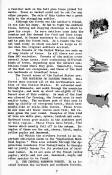 |
| 8 |
0008 |
It extends through the central part of
the country as far west as the Great Plains, east to the foothills
of the mountains, north to the Lake States and south into Tennessee.
It lies generally in the flat river bottoms, and rolling hills of
the Middle West. Its size has teen greatly reduced by clearing land
for farms, and today is one of our smaller forest areas. Hardwoods
make up the main type of trees in this area, examples of which are
oak, sugar maple, yellow poplar, white ash and basswood.
3. THE SOUTHERN FOREST. Lying south of
the central hardwood forest, it contains most of the southeastern
states extending up the Atlantic Coast to Maryland, up the
Mississippi River to Illinois, and west into Texas. This contains
about one-third of the wooded area of this country. Southern yellow
pine and cypress are the important evergreen trees, but hardwoods
are also important to this area. The principal hardwoods are the
oak, gum, cottonwood, hickory, pecan, yellow poplar and willow.
4. THE ROCKY MOUNTAIN FOREST. It covers
the slopes of the Rocky Mountains and extends from Canada to Mexico.
The forest land is broken up by mountains and grasslands. Only a
small part of the area supports commercial logging operations. The
most important trees are ponderosa pine, Douglas fir, western white
pine, lodgepole pine and western larch.
5. THE PACIFIC COAST FOREST. Lying on
the western side of the Rocky Mountains it extends from Canada to
Mexico. Trees found in this area are the Douglas fir, sugar pine,
western cedar, western hemlock, the true fir and the giant sequoia
and redwood trees.
It was during the 19th century, when
America attained its greatest population growth, that large areas of
the land were cleared of trees. Uncontrolled forest fires also
destroyed much tree growth. In those early days some loggers
followed poor cutting practices. In many instances the logger was
the only landowner and business enterprise furnishing taxes to a
particular area. Some tax assessors took advantage of this situation
and taxed the logger for more than the value of his timber. In order
to protect himself, the logger had to complete his operation as
quickly as possible and this helped contribute to the "cut out
8
|
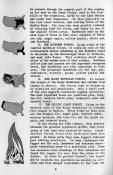 |
| 9 |
0009 |
and get out" policy, as we call it now.
Also forestry was a little known science
in early America. Many of the foresters who practiced in the United
States were trained in European methods by European teachers. These
methods were not successful here because the forest conditions were
not the same as in Europe. However, foresters continued to study
local conditions and soon realized that a balance was essential
between silvi-cultural practice and economic needs. Today many
foresters are employed by wood-using industries and are working
toward the one goal of protecting, managing and harvesting our
forests so they will always produce trees for our use.
STUDY OF WORDS IN THE TEXT
ECONOMY — the consideration of costs and
returns in producing materials.
SETTLER — one who settles, becomes
fixed, or establishes himself in a new colony or area.
EVERGREENS or CONIFERS — trees that have
needle-like or scale-like leaves and usually do not shed them in the
fall but remain green the year around. They also bear seeds in
cones. These trees are also called softwoods.
HARDWOODS — trees with broad leaves that
usually drop off in the fall.
KING'S BROAD ARROW — a mark in the form
of an arrow on the trunk of a tree to show that it was reserved for
the King's Navy.
COASTAL PLAIN — the portion of land
lying between the ocean and the foothills of mountains.
SILVICULTURE — the science of producing
and tending a forest. Through the practice of silviculture repeated
crops of timber can be grown on the same land year after year.
FOREST PRODUCTS — products that come
from trees in a natural state or converted state by mechanical or
chemical means.
GREAT PLAINS — starting on the east with
the Mississippi Valley, west to the Rocky Mountains.
REVIEW QUESTIONS:
1. Who were the first white men to come
to America? Why did they come to this country?
2. How much of our country was covered
with trees at that time?
9
|
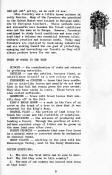 |
Chapter 2
page 10 |
0010 |
3. What use did England make of the
forest products from the New World?
4. What are the five big forests in the
United States? Which of these forests occur in our state?
5. What is an important subdivision of
the Northern Forest?
6. How much of the original forest
remains today? Explain what happened.
7. What was wrong with our early
attempts at the practice of forestry?
8. How is this being corrected today?
SOME THINGS TO DO AFTER STUDYING THIS
LESSON
1. Color a map of the United States
showing where our forests grow.
2. Get a history book and study in more
detail the early settlement of the country.
3. Find out the names of five trees
growing in the Appalachian Hardwood Region.
Chapter Two
FORESTS AND OUR DAILY LIVES
The Appalachian Hardwood Region is the
area lying in the Allegheny Mountains between Pennsylvania and
Georgia. Within its boundaries grow some of the finest stands of
hardwood timber in the country. For many years after the settlement
of the coastal plains the Allegheny Mountains were considered the
far west. Until the discovery of Cumberland Gap in 1750, few
pioneers attempted to cross the rugged mountain ranges. Hunters, who
ventured into the area, returned with glowing tales of the country's
beauty. They reported clear streams flowed through the mountain
valleys, game was plentiful and trading with the Indians was easy.
With the discovery of this relatively easy
10
|
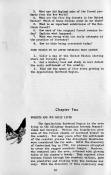 |
| 11 |
0011 |
route over the mountains, a way was
opened for settlement.
Daniel Boone, an original pioneer of
this area, in 1779 was hired by the Virginia Legislature to build a
road through the Gap into the country beyond. He built what became
known as the "Wilderness Road." From 1779 to 1795 a steady stream of
settlers flowed acress the mountains, but few people stopped to
settle in the rugged mountains of the Appalachian territory. Most of
the people continued on to the low, rolling hills and river bottom
lands of central Kentucky and beyond.
Farther south, settlers from North
Carolina traveled over the mountains and down the rivers by flat and
keel boats to settle in Tennessee and western Kentucky. One of this
important group was the Transylvania Company led by Richard
Henderson. The rugged mountains discouraged any great settlement,
and most of the group moved beyond the mountains to establish new
homes.
The results of this migration can be
seen in the timber stands of the country today. Within the
Appalachian territory there still are vast, unbroken forest areas.
Farther west beyond the mountains in Kentucky and Tennessee, the
forest land is in small tracts and farm woodlands, due to settlers
needing more land to produce farm crops.
When steamboat navigation started on the
Ohio River, travel left the overland route, and the mountainous
section became more or less isolated from the outside world.
However, scattered logging operations were active near the river
courses as early as 1825. But it was not until 25 years after the
close of the "War Between the States," when mineral deposits of coal
and iron were discovered, that the railroads pushed into the
mountain sections with new transportation systems. The coming of the
railroads offered an outlet to the outside markets for the timber in
this territory. Great band sawmills were set up to saw the yellow
poplar, white oak and other species which grew in abundance in the
region. This wood was used for paneling, furniture, flooring and
other items requiring material with close grain, fine texture and
figure.
The rugged nature of the country
discouraged any extensive land clearing for farms. The conditions of
soil, climate and topography, how-
11
|
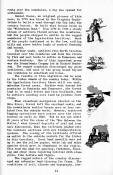 |
| 12 |
0012 |
on paper made from wood, and many of the
plastic products today are made with wood via chemical processes.
In the Appalachian region much of the
economy is based on the production of coal. Large amounts of timber
in the form of headers, props, ties, wedges and cross bars are
needed to mine the coal. It takes about four board feet of -wood to
mine a ton of coal, and over 200,000,000 tons are produced annually
in the Appalachian Hardwood Region.
In the cutting, sawing and processing of
logs in the Appalachian region many jobs are furnished for people.
Men are needed to cut the trees, saw them into logs and haul them to
sawmills. There the logs are cut into lumber and timbers. Other
plants process them into flooring, panels, furniture and various
finished products. The wages paid the men furnish money for rent,
food, clothes and the necessities of life. Altogether the forest
industries of this region employ more than 50,000 men. Thus you can
see that the forests of this region play an important part in the
daily lives of the people. Coal miners have an interest in the
forest too. Their jobs are dependent on the timber used in mining
coal, and by preventing forest fires the trees are protected and
allowed to grow for future use.
Every day the forests also affect the
lives of school children. And you, the men and women of tomorrow,
can and do affect forestry. Although forestry practices in the
territory are making rapid strides, the future progress will depend
on your cooperation and support. Take care of the forests and they
in turn will take care of you. Trees were put here to use. Timber is
our only natural renewable resource and when our forests are
properly managed and protected they can supply all of our needs for
the future.
In addition to supplying wood for our
use, forests help hold water in the soil, which prevents floods;
forests furnish food and cover for our wildlife; and forests too
furnish places of recreation and enjoyment for people.
STUDY OF WORDS IN THE TEXT
VIRGIN FOREST — a forest from which
trees have never been cut.
GROWING SEASON — the time of year when a
tree grows. This is usually during the spring, summer
13
|
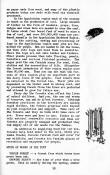 |
| 13 |
0013 |
on paper made from wood, and many of the
plastic products today are made with wood via chemical processes.
In the Appalachian region much of the
economy is based on the production of coal. Large amounts of timber
in the form of headers, props, ties, wedges and cross bars are
needed to mine the coal. It takes about four board feet of -wood to
mine a ton of coal, and over 200,000,000 tons are produced annually
in the Appalachian Hardwood Region.
In the cutting, sawing and processing of
logs in the Appalachian region many jobs are furnished for people.
Men are needed to cut the trees, saw them into logs and haul them to
sawmills. There the logs are cut into lumber and timbers. Other
plants process them into flooring, panels, furniture and various
finished products. The wages paid the men furnish money for rent,
food, clothes and the necessities of life. Altogether the forest
industries of this region employ more than 50,000 men. Thus you can
see that the forests of this region play an important part in the
daily lives of the people. Coal miners have an interest in the
forest too. Their jobs are dependent on the timber used in mining
coal, and by preventing forest fires the trees are protected and
allowed to grow for future use.
Every day the forests also affect the
lives of school children. And you, the men and women of tomorrow,
can and do affect forestry. Although forestry practices in the
territory are making rapid strides, the future progress will depend
on your cooperation and support. Take care of the forests and they
in turn will take care of you. Trees were put here to use. Timber is
our only natural renewable resource and when our forests are
properly managed and protected they can supply all of our needs for
the future.
In addition to supplying wood for our
use, forests help hold water in the soil, which prevents floods;
forests furnish food and cover for our wildlife; and forests too
furnish places of recreation and enjoyment for people.
STUDY OF WORDS IN THE TEXT
VIRGIN FOREST — a forest from which
trees have never been cut.
GROWING SEASON — the time of year when a
tree grows. This is usually during the spring, summer
13
|
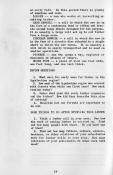 |
| 14 |
omitted |
|
|
Chapter 3
page 15 |
0014 |
Chapter Three
THE GROWTH OF TREES
Little drops of water,
Little grains of sand,
Make the mighty ocean,
And the pleasant land.
As you walk through the forest and gaze
upon the beautiful trees, it is hard to realize that they were once
tiny seeds. All trees begin as tiny seeds. Even the great oak was
once a small acorn about the size of a marble. Inside the acorn food
and water are stored. This food and water is used for the first few
days of growth until the young seedling, which sprouts from the
acorn, can produce roots, stem, and leaves to make its own food.
While nature provides everything to make
the seed grow, nature also offers great opposition. From the
beginning each seed must compete with its neighbor for water, food,
sunlight, and space in which to sprout and grow. Trees produce
thousands of seeds. Only a few of them grow into big trees. Many are
eaten by squirrels and mice. Others are destroyed by insects. Others
never find suitable soil and moisture conditions under which to
sprout and grow.
All seeds are alike in some ways. Nature
first protects them with a strong cover with food stored inside.
When the seed starts growing part of it goes down inside the earth
and is called the root; another part grows out of the ground and is
called the stem on which leaves form. The roots take water out of
the soil, and the leaves absorb sunlight and moisture from the air.
Nature gives all seeds a particular
characteristic. An acorn will always grow into an oak tree, and a
pine seedling will always grow into a pine tree.
Some seeds ripen on the tree and fall
off in the spring and begin to grow right away. Others ripen and
fall off in the autumn. Such seeds must wait until winter is over
and spring comes before they start growing. When warm weather comes
all of nature begins growing.
Some seeds fall off a tree and begin
growing where they fall. Others are carried by the wind,
15
|
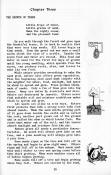 |
| 16 |
0015 |
birds, animals, and water to distant
places. The maple, yellow poplar and ash have wings that make it
easier for the wind to blow them to distant places. Squirrels carry
acorns from under the tree and bury them in other areas.
But in order for all seeds to sprout and
develop they must have food, water, sunlight, and warmth. Until it
gets roots, a stem above ground, and some leaves or needles, the
seed uses the food stored in its shell to make growth. As the roots
go deeper into the soil they absorb water and minerals from the soil
and send these up into the stem. The leaves act as a chemical
laboratory for they take carbon dioxide and water from the air, and
make starches and sugar on which the tree feeds. The leaves also
give off oxygen which purifies the air. Water is also given off by
the leaves in. large quantities.
All trees manufacture more food than
they need for growing. The extra food is stored in the tree cells
for use in the spring when it puts out leaves, flowers, and seeds.
A tree grows upward from the tips of the
branches, downward from the roots, and outward from the trunk. The
roots anchor the tree to the ground, and the trunk gives support to
the branches.
As the tree grows from the food it
manufactures, it adds new layers of wood to its trunk. These layers
are called annual rings, and may be used to tell the age of the
tree.
The rings are made up of two parts:
spring-wood, formed in the spring; and summerwood, grown in the
summer. The springwood is formed with cells or tubes running up and
down the length of the tree to transport the water the tree needs.
The summerwood is made of smaller cells in larger numbers which give
strength to the stem of the tree. Fast growing hardwood trees
produce more summerwood than springwood. Slow growing hardwood trees
have less summerwood. These trees are fine in texture, close in
grain, and are easily made into useful and beautiful products.
Growing conditions found in the Appalachian region give trees the
characteristics desirable in high quality hardwoods.
This is a description of the cross
section of a tree trunk which is also called the stem of a tree. The
outside is called the outer bark. This is dead material and is the
outside protec-
16
|
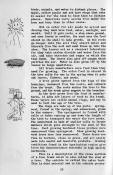 |
| 17 |
0016 |
tion for the growing part of the .tree.
Next is the inner bark, composed cf living cells, through which
water and food is conducted down into the tree, giving life to its
roots and other parts. Next is the cambium layer, which you cannot
see in a cross section without a magnifying glass. The cambium layer
is made up of cells, some of which later make bark and some of which
make wood. Next is the sapwood, also composed mostly of living cells
through which food and water are collected by the roots and sent- up
to the branches and leaves.
We next come to the heartwood of the
tree, which is in the middle of the stem. This is composed of dead
cells, but strong enough to give the tree strength to stand. The
heartwood was once sapwood but when new sapwood formed, the older
sapwood died and formed the heartwood of the tree.
As you study the cross section you will
note that some of the annual rings are wider apart than others. When
you see a wide space between the rings this means the tree grew
faster at that time because it got more sunlight, water, and food.
Lack of sunlight, food, water and even forest fires slow down the
growth of the tree and make the rings closer together and narrow in
width.
A tree grows during late spring, summer,
and early fall, which is called the growing season. Conditions of
soil and climate in the Appalachian territory are well-adapted for
the growing of trees.
After a tree is full grown, it is ripe,
and should be cut, before it begins to rot. From the wood of the
tree can be made furniture, paneling, crossties for railroad tracks,
or timbers for use in a coal mine. When mature trees are cut room is
made for other trees to grow that will also reach maturity and be
cut, if they are protected from fire, disease and insects.
Many wood-using industries today are
taking proper care of the forest and cutting the trees wisely so
that other trees will grow up. As this practice continues we will
have trees growing forever to make the products we need in our daily
lives.
17
|
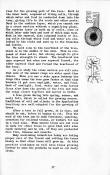 |
| 18 |
0017 |
STUDY OF WORDS IN THE TEXT
CARBON DIOXIDE — a heavy colorless gas,
composed of one part carbon and two parts oxygen. It is one of the
gases in the air.
DORMANT — sleeping; not in action; in
this instance the period when a tree is not growing.
CHEMICAL LABORATORY — a laboratory where
substances are studied for their parts, and changes they undergo.
STARCH — a white, odorless, tasteless,
granular or powdery, complex carbohydrate composed of carbon,
hydrogen and oxygen in varying amounts.
ANNUAL RING — one year's growth as seen
in a cross section of a tree trunk. It contains both springwood and
summerwood growth of the same year.
CLOSE GRAIN — wood having narrow annual
rings that are hard to see.
FINE TEXTURE — wood having small, even
cells which have thin walls and are closely-spaced.
GROWING SEASON — the period of the year
in which a tree grows, usually during spring, summer and fall.
REVIEW QUESTIONS
1. Name two means by which seeds are
scattered.
2. In what part of the tree is food
manufactured?
3. What do the roots do for the tree?
4. What is the difference between
heartwood and sapwood?
5. What is the cambium layer?
6. What four things does a tree need to
grow?
SOME THINGS TO DO AFTER STUDYING THIS
LESSON
1. Plant an acorn in the soil and watch
it grow.
2. Cut a cross section of a tree trunk.
Locate the annual rings, the sapwood, heartwood, inner and outer
bark.
3. Study a seedling. Note the roots, the
stem, the leaves and branches.
18
|
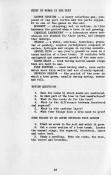 |
Chapter 4
page 19 |
0018 |
Chapter Four
IMPORTANT TREES OF THE APPALACHIAN
HARDWOOD REGION
In the Appalachian Hardwood Region there
are over 60 different kinds of trees that grow large enough to make
lumber. Roughly one-half are hardwoods, but lumber production is
about 70 percent hardwoods and 30 percent softwoods. Not all plants
with woody stems are trees. Only those that reach a height of over
20 feet when full grown, have one trunk and a well-formed crown are
called trees. Other woody plants are called shrubs.
In this chapter we will study a few of
our important trees that are valuable as lumber. Trees are divided
into two main groups — the conifers or softwoods and the hardwoods.
Conifers bear their seeds in cones, while hardwoods sometimes have a
fruit similar to a cone, but usually have seeds in the form of nuts,
like the oak, or in the form of fruit, like the cherry.
When the cones of the conifers ripen,
the scales that make up the cone and hold the seed, open and let the
seed scatter over the ground or be carried to a distant area by the
wind. Conifers have long, narrow, needle-like leaves which usually
stay on the tree the year round even in winter. Conifers include the
pine, fir, hemlock and cedar.
Hardwoods have broad flat leaves which
usually fall off during the fall. Seeds fall to the ground and
sprout there unless carried to another area by animals, birds, wind
or water. Hardwoods include the oak, yellow poplar, maple and beech.
A beautiful sight in the forest is the
color-fulness of the leaves on the hardwood trees in the fall. Many
people travel long distances to see the red, yellow, orange and
other colors wrought by nature at this time of the year.
The names "hardwood" and "softwood" are
used because the broadleaf trees generally have harder
wood than the conifers. There are
exceptions to this rule. For example, the wood of some of the yellow
pine (softwood) is harder than basswood or yellow poplar (hardwood).
The Appalachian forest is remarkable for
the variety of hardwoods found in it. Except
19
|
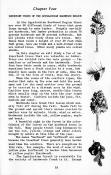 |
| 20 |
0019 |
for about four species that prefer the
warm moist lowlands of the south, and one or two others found in the
cold north, every commercial hardwood of the United States is at
home in the Appalachian region.
Following are some details about
hardwood trees; what they are used for; how they grow; and how to
recognize them.
YELLOW POPLAR
One of the world's oldest trees is the
yellow poplar. It is one of the tallest hardwood trees in America,
sometimes reaching heights of 150 to 200 feet. Yellow poplar, or
tulip as it is sometimes known, is not a true poplar. It belongs to
the magnolia family.
For identification the tree has
three-lobed leaves, with the top lobe square cut. It is like no
other tree leaf in the forest. The leaves are four to eight inches
long and almost that wide. Another unusual feature is the flower,
which blooms in April or May. It is tulip-shaped with markings
varying from yellow-green to orange. The name "tulip-tree" comes
from this flower.
Yellow poplar makes its best growth on
the deep, well-drained soils of the coves and on the lower slopes of
the mountains. In the old stands, they are found as scattered
individual trees. On cut-over land, where the mineral soil has been
exposed, the tree will seed in and form pure stands. They can be
seen easily in the spring as they are the first to put out leaves.
This tree needs plenty of sunlight. The small branches that the
sun's rays do not reach die and fall off. The trunk grows straight
and clear. For this reason the lumber is of high quality and
valuable. About one-third of the yellow poplar produced in this
country comes from the Appalachian region.
THE OAKS
This is the most important hardwood
family on the North American continent. In the United States there
are about 75 different kinds. About 15 of these are found in the
Appalachian Hardwood Region. White oak and red oak are the two main
kinds. A characteristic of most oaks is their deeply-lobed leaves.
20
|
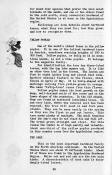 |
| 21 |
0020 |
WHITE OAK
These are the most valuable trees of the
oak family. They grow over a large part of the region, but make
their best growth on the north and east slopes of the higher ground
and near the stream banks. They sometimes reach diameters of 7 to 9
feet and heights of 150 feet. White oak acorns ripen each fall, are
sweet, and some species can be eaten. History tells us that Indians
and early settlers used white oak acorns for food. Leaves of the
white oak have rounded edges without points. The tree has light-grey
bark. Other white oaks are the chestnut oak, the post oak and
overcup oak.
The greyish-brown wood of the white oak
which grows in the Appalachian Hardwood Region has a fine texture,
close grain, beautiful design, and is quite easy to work. It is in
great demand for high-grade furniture, paneling, interior trim and
flooring.
RED OAK
Red oak differs from white oak in many
ways. The leaves of red oak have sharp little bristles on the tips.
The acorns require two years to ripen on the tree; are bitter and
not good to eat. The bark is dark brown to black in color and often
rough, with deep grooves running up and down or crosswise. Some
well-known red oaks are: black oak, pin oak, southern red oak, and
northern red oak. Red oak grows on higher slopes in mixture with the
hickories, white oaks, and other kinds of trees.
The wood of the red oak is reddish-brown
in color, and unlike the white oak, the pores are not stopped up. A
piece of red oak wood one foot long can be blown through. It is used
for structural timbers, flooring, furniture, trim and railroad ties.
BEECH
Beech is a wood that has recently come
into its own as a marketable tree. In many lumber operations in the
past, beech trees were not cut. The wood was hard and heavy. In
earlier years
21
|
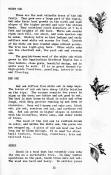 |
| 22 |
0021 |
the wood was hard to work with the
equipment then available, and difficult to dry without checking and
warping. The outstanding characteristic of the beech tree is the
tight, smooth, light-grey bark. Everyone who has ever walked in a
beech forest has probably carved his initials on the bark of the
tree. Until a few years ago, a beech tree stood in Roane County,
Tennessee, inscribed with "D. Boone cilld Bar on Tree 1769," which
indicated Boone had killed a bear in the tree in that year. In bear
country, claw marks are usually prominent on the bark where bears
have climbed the tree to get the beech nuts.
The leaves are 4 to 6 inches long and 2
to 3 inches wide, tapering to a point at the top, with rough, spiny
edges. The buds are also distinctive in that they have the
appearance of miniature
cigars. The fruit is two small
triangular nuts enclosed in a burr. The successive removal of other
kinds of trees has resulted in many pure stands of beech in the
region. These pure stands should be cut to give other kinds of trees
a chance to grow.
Beech takes a high polish. Floors made
of beech heartwood are beautiful, and the wood is used for factory
floors, plane stocks, shoe lasts and handles. While beech will last
indefinitely when kept dry, it is one of the least durable hardwoods
when exposed to moisture for a long time. Many of the standing trees
today are partly rotted away. Much of this rot is due to fires
scarring the tree as the beech bark is thin and the tree easily
damaged by fire.
SUGAR MAPLE
Sugar maple is a northern tree but it
makes excellent growth at higher elevations of the Appalachian
region. In the north country, where weather conditions are
favorable, its sap is made into maple syrup and maple sugar. In the
Appalachian region the tree grows to large size, and its lumber is
valuable for many uses. Recognition of the tree is easy. The leaves,
which .grow opposite each other on the branches, are about 5 inches
long and about the same width. They are lobed like the fingers of
your hand, and have smooth edges. In the fall they turn a beautiful
scarlet and yellow color. The fruit is in the form of winged seeds
which are made in pairs, usually only one containing a full grown
seed. The ripe
22
|
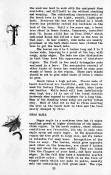 |
| 23 |
0022 |
seeds fall from the tree in the autumn
and are carried and spread by the wind over the countryside.
Although some seeds are produced each year, at two and four year
intervals "seed years" occur and the tree produces seed in large
quantities. The wood of the sugar maple is hard and fine-textured.
This is desirable in high-quality lumber, which is used for
flooring, interior finish, furniture, shoe lasts, bowling pins and
handles. A large part of the Appalachian maple wood is light
colored.
BASSWOOD
This is an important, timber tree and
makes its best growth in the Appalachian region. It grows best on
deep, moist soils, and is often found in mixture with yellow poplar
on the lower slopes and coves.
The leaves are broad, lopsided,
oval-shaped, and come to a sharp point at the top. They are 5 to 6
inches long and 3 to 4 inches wide. A typical characteristic of the
basswood is the fruit. It is small, round and nut-like, and hangs in
clusters of from 3 to 7 on long stems attached to the branches. In
some places basswood honey, which bees make from the flowers, is
highly prized.
The name "basswood" comes from the "bast"
or inner bark. Indians make rope by soaking the bark in water for
several weeks, allowing the non-fibrous part to rot. Then the fibers
are twisted into rope.
Basswood sprouts easily, and clumps of
sprouts around an old stump are a familiar sight in the forest. The
wood is soft, light and fine textured. It has many of the uses of
yellow poplar such as interior trim, paneling, woodenware, picture
molding, trunks and luggage.
In addition some of the evergreens of
the Appalachian region are important. They follow:
HEMLOCK
Hemlock makes its best growth on the
deep, well-drained soil along the banks of streams in the deep
hollows of the mountains. It sometimes grows in pure stands, but
more often in mixture with hardwoods and white pine.
The leaves are needle-like and
flattened, and are about one-half to three-quarters of an inch long.
Each needle has two parallel white
23
|
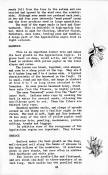 |
| 24 |
0023 |
lines lengthwise along its back. At the
top of the tree is a limber terminal shoot which can be used as a
natural compass, because it usually bends toward the northeast. The
cones are one-half to one inch long when closed and nearly round
when opened. The seeds are released in the winter and sprout in the
early spring. Many seedlings can be seen growing on rotten logs and
old stumps. The tree is able to bear considerable shade, and
branches on the trunk last for many years. This causes hard, flinty
knots on the wood. Considerable tannin is contained in the bark
which is extracted to make tannic acid and used for tanning leather.
Because the wood is strong it is used principally for construction
purposes.
SPRUCE
Several kinds of spruce grow in the
United States, but the only important kind growing in the
Appalachian region is the red spruce. In this region it is found
only on the high mountains above elevations of 3,000 feet where
growing conditions are like those in the northern range where it
also is found. At these higher elevations it grows in pure stands
and makes its best growth in the mountains of West Virginia and
North Carolina.
The needles are about one-half inch
long, four-sided and stiff. The foliage feels sharp when grasped in
the hand. The cones are about 2 inches long. Seeds are small and
winged and are scattered in the fall and winter. They start to grow
in the spring. Because the tree can stand a lot of shade it will
seed in under stands of hardwoods. Also, because of its shallow root
system, spruce is easily blown down by the wind.
In harvesting the trees, not more than
one-third of the stand should be cut at any one time, or else the
tract could be clear cut in strips. The wood is strong for its
weight and is used in making boat oars and pike pole handles.
Because it has a good resonance quality it is widely used for
sounding boards in pianos and in violins. The wood is also used for
aircraft veneer.
Other evergreens in the region are white
pine, red cedar, and yellow pine.
STUDY OF WORDS IN THE TEXT
PANELING — panels are boards shaped for
use
24
|
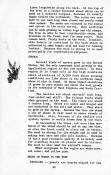 |
| 25 |
0024 |
in constructing a wall in a house or
building.
VENEER — wood cut in sheets either by
turning the log against a knife on a lathe, or slicing off thin
sheets by moving a log up and down against a knife.
SPROUT — a tree that has grerwn from a
stump or root.
MINE PROP — a post used in the coal
mines to support the roof.
DURABLE — able to endure or continue in
a particular condition; lasting; not perishable; does not decay
easily.
CROSSTIES — wooden timbers on which
railroad tracks are laid.
TREE — a woody perennial plant having a
single main axis or stem (trunk), commonly exceeding ten feet in
height and usually devoid of branches below, but bearing a head of
branches and foliage or a crown of leaves at the summit.
CROWN — the top portion of a tree
containing the leaves and branches.
RESONANCE — the ability of a material to
intensify or enrich a sound by vibration.
REVIEW QUESTIONS
1. What are some of the differences
between evergreens and broadleaf trees?
2. Name some of the important hardwoods
growing in our territory. Give some uses of each.
3. Head one column "white oak" and
another "red oak." List the differences between the two.
4. Why is yellow poplar which grows in
the Appalachian region one of our most valuable trees? Name two
important products made from its wood.
SOME THINGS TO DO AFTER STUDYING THIS
LESSON
1. Collect leaves of five different
trees. Get some printer's ink, a one-inch board about 12 inches
square, and a rubber roller. Spread the ink over the board. Press
the back of the leaf into the ink on the board, remove it and press
on a piece of white paper and roll with roller. This will make a
print of the leaf on the paper.
2. Collect small branches from several
different species of trees. Cut them lengthwise down the center.
Note how differently the pith is constructed in the various species.
25
|
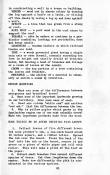 |
Chapter 5
page 26 |
0025 |
Chapter Five
PRODUCTS OF THE FOREST
Wood, a product of our forests, is a
widely used and versatile material. Wood enters into our daily lives
possibly more than any other substance. It appears not only in its
original state but in other forms, made possible through chemical
processes.
Wood and wood products are everywhere.
Your books and pencils are made of wood. There is wood in your home,
in your chair or desk at school, in the newspapers delivered to your
homes. Wood may be seen in fence posts, telephone and electric light
poles, houses, barns, and other buildings. Wood is used also for
crossties for railroad tracks, boxcars, the manufacture of house and
office furniture, the production of flooring, and other uses. In
all, wood in its natural and converted state is used in more than
4,000 ways.
There was a time when we could recognize
all products made of wood. This is no longer true. Modern science
has brought us new and useful things — made of wood but not
necessarily resembling wood in its original state.
The telephone receiver in your home is
made of plastic. Fountain pens, many automobile accessories, radio
cabinets, airplane turrets, bookends, ashtrays, and numerous other
objects are made of plastic. Much of this plastic is a by-product
made from wood.
During World War II wood became more
important than ever before. The Germans used wood to make
explosives, cloth for uniforms, feed for cattle, and gas with which
to run automobiles. Japan recognized the importance of wood to our
war effort. The one bomb the Japanese dropped on this country was an
incendiary bomb aimed at our forests.
The fastest bomber used in the war was
the English "Mosquito." The body and wings were constructed entirely
of wood. The United States made the famous "P-T boats" of wood, and
many of our large cargo planes were made of wood.
But, as we mentioned earlier the use of
wood is not confined entirely to weapons of destruction. Today, we
find wood is one of our most useful products to help make our lives
comfortable.
26
|
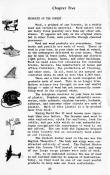 |
| 27 |
0026 |
The growing conditions found in the
Appalachian Hardwood Region produce wood that is called "fine
textured and close grained." This property makes wood easy to work,
gives a quality of "staying put" and an appearance of beauty when
used in panels, flooring, furniture and inside trim.
"Appalachian" is the wood to ask for
when these qualities are desired. Each tree of the following has
qualities which make its wood especially desirable for certain
special uses.
APPALACHIAN WHITE OAK
The Appalachian region produces white
oak of high quality. It is strong, stiff, moderately hard, and is
resistant to shock and wear, such as it receives in flooring.
Because its growth rate is even, the wood structure is uniform and
the wood has fine texture and a close grain pattern. It shrinks and
swells little with changes in weather. These advantages make
Appalachian white oak particularly suitable for the manufacture of
fine furniture, flooring, paneling and cabinet work in which the
quality of "staying put" is highly desirable.
APPALACHIAN RED OAK
The physical properties of red oak
compare favorably with those of white oak. The two woods weigh about
the same, but on the whole, red oak is not quite as hard or as
strong. The principal difference is found in the structure of the
wood. Red oak usually grows more rapidly than white oak and has, on
the whole, wider annual rings and a somewhat more pronounced grain
pattern. The pores in red oak are open and you can blow through a
thin piece of the wood. The pores of white oak are filled with thin
walled .cells. For this reason, red oak can be more easily treated
with preservatives than white oak. This is a desirable quality when
it is used for railroad ties or mine timbers.
Two different types of sawing are used
to present different grain patterns in the oaks. The oaks not only
have growth rings which make grain patterns, but also wide medullary
rays.
In the plain sawing, the cut is made
parallel to the annual rings and across the rays. This gives the
familiar pattern in which the rings
27
|
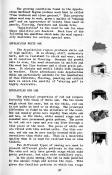 |
| 28 |
0027 |
appear as wavy, or "U" shaped lines,
with the rays as short dash lines.
In quarter sawing, the cut is made so
that the annual rings form an angle of 45 degrees or more with the
surface of the board. This results in the rings appearing as narrow
parallel lines along the length of the wood and the rays appearing
as rectangular blocks or broad wavy lines.
Plain and quarter sawn lumber are
affected equally in shrinking and swelling but quarter sawn is
affected less across the width of the board.
APPALACHIAN YELLOW POPLAR
This wood has a fine texture, and is
straight with close grain. It is moderately strong, hard and light
in weight when kiln dried. Its heart-wood is greenish-yellow in
color and durable when used for painted exterior millwork.
Appalachian poplar is unexcelled as a hardwood from the standpoint
of being worked. It is easily seasoned and can be worked into sizes
and shapes with smooth surface and edges. It keeps its shape and
size after being milled. These qualities have made it one of our
choice cabinet woods.
The wood absorbs glue evenly, resulting
in strong joints. It is also one of our best woods for painting and
enameling.
Appalachian yellow poplar is used for
core stock, counter tops, shelving, paneling and other similar wide
surfaces. It is widely used for house siding, door and window
casing, all types of furniture and cabinet work, and in industrial
arts and vocational school classes.
APPALACHIAN BEECH
Appalachian beech is a hard, strong wood
with fine uniform texture and close grain pattern. In the log a
narrow, light-colored ring of sapwood surrounds the reddish-brown
heartwood, both of which can be finished attractively.
With the development of new methods in
drying and handling beech lumber, many of the difficulties resulting
in checking and warping have been eliminated. Beech is now much more
in demand for flooring and furniture than it was once.
Beech has excellent wearing qualities. A
floor of beech heartwood is both beautiful and
28
|
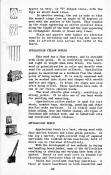 |
| 29 |
0028 |
serviceable. Furniture manufacturers who
wish to offer economy and long wear in their product could think
seriously of using Appalachian beech. Other important uses are broom
and mop handles, dishes, bowls, clothespins, brush handles and toys.
Many other fine woods are grown in the
Appalachian region. A partial list includes: white ash, cherry,
hickory, hard maple, soft maple, yellow birch, basswood and
butternut. All occupy an important place in the hardwood lumber
industry, and Appalachian hardwoods are often specified
when high quality woods of fine texture
are desired. STUDY OF WORDS IN THE TEXT
GROWING CONDITIONS — the combination of
soil and climate which together affect the development of trees.
ABRASION — the act of wearing something
away by friction.
MEDULLARY RAY — narrow lines showing in
the cross section of a log, fanning out from the center like the
spokes of a wheel.
KILN DRIED — wood which has been placed
in a heating device designed to remove most of the moisture.
SEASONED — subjected to drying.
MILLING — put through wood working
machinery.
CHECKING — splits and cracks in boards
resulting from improper drying.
CORE STOCK — the interior bands of wood
in plywood.
REVIEW QUESTIONS
1. Name some important war materials
made from wood.
2. What are wood plastics?
3. Name five important woods which come
from trees of the Appalachian region.
4. Name three characteristics which make
these woods so desirable for the use to which they are put.
SOME THINGS TO DO AFTER STUDYING THIS
LESSON
1. Collect some samples of plain sawn
and quarter sawn white oak.
2. Try to collect a sample of each of
the woods found in the Appalachian Hardwood Region.
29
|
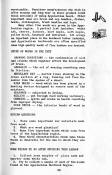 |
Chapter 6
page 30 |
0029 |
3. Look at your school desks and floors.
What kind of wood are they made of?
Chapter Six
CARE OF OUR FORESTS
Coal mining is the livelihood of a large
number of persons in the Appalachian Hardwood Region. The lumber
industry also provides a living for many workers in the area. Large
quantities cf timber are required to mine coal and keep the sawmills
running. To insure a future supply of needed forest products,
adequate fire control and sound forestry practices are necessary.
The development and maintenance of a
forestry program is a job for private industry. The Appalachian
Hardwood Region is an area well suited by soil, climate and
topography to the growing of timber. With proper forestry measures,
these timber stands will renew themselves and maintain an adequate
supply of wood to meet the demands of the vast coal and lumber
industries located within the region. With this thought in mind, the
Appalachian Hardwood Manufacturers, Inc., has established a Forestry
Division. It has invited into membership not only the producers of
Appalachian hardwood lumber, but landowners and coal operators, as
well, who have a vital interest in the proper use of available
timber.
The forestry program, like other
progressive developments, has several aims: first, to establish good
forestry practices on the lands of the members; second, to support
legislation on a state level favorable to forestry, the lumber
industry and related activities; third, to obtain a larger
membership so the work can be increased; and fourth, to establish a
research program that will give us the answers to many of our
problems and show the value of forestry practices in the woods.
30
|
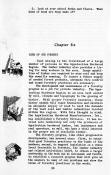 |
| 31 |
0030 |
To be successful, a forestry program
must
be sold to three groups: the landowners,
the loggers and the tax assessors. To be practical, it must be worth
the money invested in it.
In the establishment of a forestry
program, the first consideration is the control of forest fires.
This is a job best accomplished by state forestry organizations
established for the purpose. The Forestry Division of the
Appalachian Hardwood Manufacturers, Inc., is supporting programs
which will efficiently man, equip -and finance these state
organizations to prevent and suppress forest fires in the several
states within the Appalachian Hardwood Region. Cooperative
agreements between landowners and operators and the state
organizations are encouraged.
By watching forestry demonstrations,
lumbermen can learn proper cutting practices. These practices must
maintain a balance between maximum growth of trees and the needs of
the operator. Through good forestry practices, we make sure we get
the greatest amount of wood from the trees and the most and best
trees from the soil. Foresters show us how stands of trees should be
harvested so that we will always have enough trees to supply our
needs.
We produce more wood from the soil on
small trees left to grow than from seedlings or sprouts after
clear-cutting. In developing long-time plans for cutting the timber,
trees can be selected for cutting which will give the operator an
economic cut, supply the needs for coal or lumber production, and
leave a stand of smaller trees that will insure a future cut. when
the current logging operation is completed, the roads should be
seeded with grass. Then rainfall and running water will not wash the
road away. If this is done, the road will be ready for use on the
next cut, and very few repairs will be necessary.
When the trees are marked for cutting,
the forester's job is only half done. Full utilization of the wood
in the trees is necessary. We cannot recommend forestry measures to
be followed unless we can also show the logger how he can carry them
out and make money from his operations. In the old stands of virgin
timber, births and deaths of trees were constant and resulted in
little change in the total volume of wood in the forest. These
virgin stands of timber contained
31
|
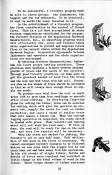 |
| 32 |
0031 |
many large trees. In order to harvest
them, special equipment was needed. The removal of these large trees
was necessary in order to get the stands of timber in shape to
practice forestry.
Today, in our second-growth stands of
timber, we have an entirely new forest economy and must adapt our
tools, our equipment, our operating methods and our thinking to meet
the new situation. We have many problems before us that did not
exist in the operation of the stands of virgin timber. In some
stands of pole-size timber we have the job of thinning to increase
the growth on the area. In others, the problem is to remove large,
defective trees in order to put the stand in. proper condition to
practice forestry on a sustained yield basis.
In the Appalachian Hardwood Region
natural conditions vary so widely that no general set of rules can
be set up to cover all forestry and marking practices in the area.
By field demonstrations and educational programs showing cutting
practices and logging methods under different conditions, we can
show the best practices to be followed under the different
conditions represented. In coal mines, wood decays quickly. In order
to prevent this, the wood is treated with chemicals. This makes the
mine timbers last longer. Therefore, treated timbers do not have to
be replaced as often as untreated wood, and the volume of wood
required to mine the coal is reduced. Considerable money for labor
is also saved when the timbers do not have to be replaced. By
leaving the smaller trees to grow in the woods, we produce the most
volume of wood from the soil and the most lumber for each day of
labor. In harvesting only the larger trees, we also increase the
quality of our product and insure a future crop. Forestry is a sound
investment on which good returns can be expected.
STUDY OF WORDS IN THE TEXT
FORESTER — a man who has been trained in
the care and use of the forest. Men go to forestry colleges to
become foresters, just as men go to college to become doctors,
lawyers, or engineers.
FOREST MANAGEMENT — to take care of a
forest according to a plan.
THINNING — removing or cutting trees
from stands of young timber that are growing too thick.
32
|
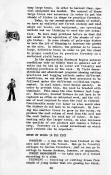 |
Chapter 7
page 33 |
0032 |
SUSTAINED YIELD — management of the
forest in such a way that the supply of timber will be maintained
forever
SECOND-GROWTH TIMBER — the timber stands
that have grown up since the virgin timber was cut off.
TREATED TIMBER — wood treated with
chemicals to prevent decay.
HEADER — a piece of timber used
crosswise in a coal mine to support the roof.
REVIEW QUESTIONS
1. Who should develop a forestry
program?
2. How can this be accomplished?
3. What should be its aims?
4. Why should we leave small trees to
grow?
5. What is the basis for a large part of
the economy of the Appalachian Hardwood Region?
6. How does this affect our forestry
problems?
SOME THINGS TO DO AFTER STUDYING THIS
LESSON
1. Get one of the state foresters or a
private forester to show you the work he is doing.
2. Talk to a lumber mill operator in
your area. See how he cuts his timber and what products he makes.
3. Visit an area in your locality which
has been cut-over within the past ten years. See if reproduction is
coming in. See if fire has been kept out.
Chapter Seven
ANIMALS OF THE FOREST
No story of the forest would be complete
without mention of deer, bear, fox, squirrel, rabbit, fish and other
animals and birds which make the forest their home. Many of these
animals live in the forested mountains and streams of the
Appalachian region, roam freely, and are known as wildlife.
33
|
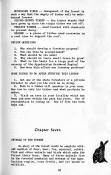 |
| 34 |
0033 |
Few Indians made the Appalachian region
their home, but many used it as a hunting ground. Game was abundant
in the region, and it made a fine place to hunt and fish. Some
wildlife, such as fox, mink, raccoon, beaver, opossum and muskrat
are valuable for their fur, and were a source of money for the early
settlers and hunters. Animals and birds were used for food by
pioneers on the march and by the early settlers until they could
harvest their first crops. The Indians had already found uses for
pelts and meats of different animals roaming the woods, and the
pioneers learned to use these in the same manner. The coonskin cap
and the buckskin shirt and breeches became a mark of distinction of
early settlers and pioneers of the region.
Our forests have changed. The Indians
have gone. Cities, highways and railroads have been built in the
area, and part of the land has been cleared for farms. The area in
which wildlife can roam has been reduced by all these changes. As
might be expected, the game population in some places has been
greatly reduced. However, it was recognized early that through
proper management, the desired population, like the forests, could
be kept large. Refuges were set aside for animals and birds. Here
the wildlife could be safe and find good food and cover and a place
to raise their young. Also, game laws were passed which set open
seasons and limited the number of animals which any one hunter could
take in a season. These rules were made so that wildlife and birds
would not be killed or disturbed during the time when they were
rearing their young. Also, hunting and fishing seasons were
established so that the meat of the animals is in the best condition
for eating at the time they are legally killed.
Wildlife is native to the land. The
animals get most of their food and shelter from the forests and
nearby lands. Therefore, in planning how to handle our forests to
get the most and best timber, we must think about the animals who
live in the woods.
Animals are a valuable source of income
to
the states in which they live. State
laws require people to have licenses before they can hunt. Through
the sale of these licenses, the state game departments often pay
their expenses
34
|
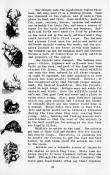 |
| 35 |
0034 |
and do not have to depend upon money
from taxes to carry on their work. Animals and birds are also
important because they destroy many insects and other enemies of the
forest and field.
Animals and birds have still another
value to you and me: recreation. Have you ever spent some of your
free hours watching birds or animals? Have you ever taken pictures
of them in their natural surroundings? Or, have you ever had the
sport of pitting your woodcraft against that of a deer, bear or bird
in hunting them in the forest? It is great sport. The ruffed grouse
is and upland game bird and its quick flight and whir of wings is a
familiar sight to all hunters. In the spring, the male grouse often
can be heard drumming on a log in the forest. The ruffed neck and
fanned tail give this bird a striking appearance.
In addition to the game animals, many
birds are present in the forest: the bluejay, woodpecker, wood
thrush, owl, chickadee, junko and others. These birds are helpful to
the forest because they live largely on insects which damage or
destroy some of our forest trees.
Some animals are known as predators.
Predators are animals or birds which destroy game animals. Some of
the common predators are foxes, wildcats, house cats which are
allowed to roam the woods, and certain hawks. Some of these animals
also kill pests, such as rats, so they are not all bad in their
habits. Predators also help to control the game population of the
forest. If too many animals are present, food becomes scarce and
many will die of starvation, especially in the rough mountains where
winters are severe.
All of the animals and birds which we
have talked about roam freely in nature. The forests and fields are
their home.
STUDY OF WORDS IN THE TEXT
GAME OR WILDLIFE — those animals native
to the field and forest.
REFUGE — an area set aside in which
wildlife is protected from hunters.
NATIVE — living in a place where one was
born.
RECREATION — some form of play or
amusement. A change from one's usual work.
PREDATORS — animals or birds which kill
game, either for food or just for the joy of killing.
35
|
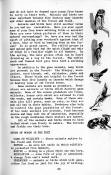 |
Chapter 8
page 36 |
0035 |
PELT — skin and fur of a fur-bearing
animal. REVIEW QUESTIONS
1. Name some wildlife native to your
state.
2. How did the early settlers make use
of the wildlife of the forest?
3. How has the development of the
country affected wildlife?
4. Name some of our native birds.
5. What is a wildlife refuge?
SOME THINGS TO DO AFTER STUDYING THIS
LESSON
1. Talk to the local game warden or game
protector. Ask him about wildlife and how it is managed.
2. See if you can find some furs. Try to
learn to identify the different kinds. A local trapper or a fur
store could show you some.
3. As you walk through the forest, make
a habit of looking for animal tracks. Learn to identify them.
Chapter Eight
TREES — FLOODS, SOIL AND CLIMATE
Besides furnishing wood, forests are
important to man in many other ways. Forests prevent soil erosion
ana floods and help maintain a plentiful water supply.
Trees, in the Middle West, are planted
in long rows called shelterbelts to protect croplands from wind
damage. Tree roots thread their way down into the ground holding
soil particles together so that they will not wash or blow away.
Tree roots also make the soil porous,
enabling it to absorb water, thereby preventing rapid "run-off." In
spring and summer, tree leaves catch rain drops as they fall,
slowing down their
36
|
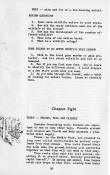 |
| 37 |
0036 |
speed. This allows more water to soak
into the ground.
To see how important this is, go out in
the country and look at a bare place on a hillside where there are
no trees or plants to catch the rainfall. There you will see ditches
or gullies caused by rapid run-off of water. This is called
"erosion."
Next, look at a wooded hillside. You
will find it free from gullies and ditches. When plowed, these steep
hillsides will yield crops for a year or two. However, the soil soon
is washed away and a new area has to be cleared. It may take nature
many years to replace the soil washed away in a single summer
rainstorm.
In speaking of erosion it is important
to know the difference between soil and sub-soil. Soil is the
weathered portion of the earth's, surface that contains plant food
in usable form. Minerals and water, found in the sub-soil
underneath, may not be in a form plants can use as food.
When water is allowed to run off too
rapidly, it not only cuts gullies but also causes floods as hundreds
of little streams merge into swollen rivers. These are sometimes
called "flash floods." Most flash floods can be prevented through
proper use of land and by maintaining forest cover at the headwaters
and on hillsides.
Farmers fertilize soil to get the best
results from plants they grow. In the forest no fertilizer is
needed. Each year leaves and branches fall to the ground and rot
leaving a soft, spongy layer called "humus." Humus enriches soil
with food which speeds tree growth. It also provides a fine place
for seeds to sprout and grow. Because it is porous, the humus layer
helps to hold water in the soil.
While forests probably have little
effect on the overall climate of a region, they do influence and
modify some weather conditions. Forests, for example, protect an
area from strong ground winds. Forests are cooler in summer and
warmer in winter than nearby open land
that is unprotected. Animals take advantage of the protection
forests provide against wind and temperature extremes.
Each gives and takes products necessary
for survival. Trees take carbon dioxide out of thin air and give off
oxygen as waste. This oxygen
37
|
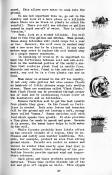 |
| 38 |
0037 |
helps maintain the supply men and
animals breathe. In their life processes animals also produce waste
which is available to trees as food. Although plants and animals are
in a constant struggle for survival, they depend upon each other in
many ways. This is called a "balance of nature."
Somewhere near your home is a place
where drinking water is stored and purified. The humus layer that
trees build up and protect, helps maintain this water supply. In
un-wooded, open areas people usually plant trees around reservoirs,
springs and wells.
There is a permanent supply of water
under the ground. The height of this supply is called the "water
table." Its depth beneath the surface varies in different areas.
Under a stand of trees the water table is usually closer to the
surface than in open land. Underground water is the source of water
in wells.
Well kept forests protect soil from
erosion, prevent floods and help maintain a plentiful supply of
water. All these services are important factors in shaping our daily
lives.
STUDY OF WORDS IN THE TEXT
HEADWATERS — the place in the mountains
where streams start.
GULLY — a ditch worn by water.
HUMUS — the top layer of forest soil
containing rotted leaves and decayed wood which fall from trees.
FOLIAGE — the leaves of the trees.
FERTILIZER — food which plants need to
grow.
OXYGEN — one of the gases in the air
which is essential for the life of all living things.
CARBON DIOXIDE — one of the gases in the
air made up of one part carbon and two parts oxygen. It is essential
to plant life.
POROUS — full of small holes through
which water can pass. Spongy.
WATER TABLE — the level under the ground
at-which permanent water is found.
FLASH FLOOD — a flood of water which
rises and falls quickly.
REVIEW QUESTIONS
1. What has been done to protect farm
lands in the Middle West?
38
|
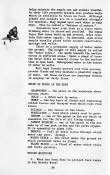 |
| Chapter 9 page 39 |
0038 |
2. Why should steep hillsides not be
used for crop land?
3. How do trees purify the air?
4. How do cities protect their water
supply?
5. How does a forest fertilize the soil?
6. Besides furnishing us with wood, what
other service does a forest offer?
SOME THINGS TO DO AFTER STUDYING THIS
LESSON
1. Visit the plant and area from which
your town receives its water supply.
2. Pour water over a plain board. Watch
it run off.
3. Pour water over a board covered with
a blanket or blotter. See how it is absorbed. This blanket or
blotter represents the spongy portion of the soil found under a
stand of trees.
4. As you walk in the forest in summer,
notice how much cooler it is than in an open field.
Chapter Nine
FOREST ENEMIES
All living things are in a constant
struggle for survival. When a plant or animal becomes weakened, it
is attacked and sooner or later killed.
One of the forest's greatest enemies is
fire. Man, through ignorance, carelessness or pure meanness, causes
most fires.
In selectively cut stands of timber,
only the larger trees are removed while the smaller ones are left to
grow. Selective cutting increases good production, and means more
high quality lumber. In selective cutting, less slash is left on the
ground after logging. This lessens the danger of fire starting in
the woods.
When a stand of timber is clear-cut, we
must depend upon the soil, seeds and sprouts to restock the land
with trees. While clear-cutting yields many logs it does not permit
the best possible production from the soil. If fire burns over a
clear-cut area there may be no future tree harvest.
39
|
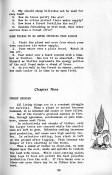 |
| 40 |
0039 |
The heavy cover of limbs and tree tops,
called "slash," which results from clear-cutting normally decays
into the soil. This makes fine fertilizer which the new crop, of
trees will need for food. However, when a fire burns over the forest
right after it is clear-cut, slash, humus in the soil, seedlings and
sprouts all are destroyed. If this happens the land cannot produce
another crop of trees for many years. With the humus destroyed and
trees removed, water, in times of heavy rainfall, runs off rapidly
cutting deep gullies. Destruction of the land, begun by fire,
becomes complete.
Whenever fire burns, young growth is
killed and larger trees are damaged. Wood growth is reduced and fire
scars are left on the trunk and in some cases far up the tree. These
scars occur on the uphill side of the tree where heat is greatest.
The bark is destroyed, exposing the wood to the attack of insects
and decay. The amount of good-quality wood available from the tree
is considerably reduced. People who purposely set fire to the forest
to get even with someone or to do harm are called willful woods
burners. They may be arrested and fined or sent to prison because it
is against the law to set fire to another man's woods.
Some people, through ignorance, set fire
to the woods to make the grass greener, or to kill snakes and ticks.
Actually, fire has little effect on ticks and snakes, but it does
rob the soil of minerals and humus. Though the land may look greener
after a fire it grows a poorer kind of grass, which has little
actual food for cattle.
Cattlemen know that stock pastured in a
forest do not put on weight nor grow into valuable beef like those
raised on grass pasture.
Some people start fires through
carelessness. All of us are careless at some time or other. However,
this does not relieve us of responsibility for the results of our
acts. People who fail to put out camp fires, those who drop lighted
matches, cigarettes, cigars or pipe heels in the woods, or persons
who leave brush fires burning, are careless. All of them start
forest fires.
Whatever the cause, the results of fire
are thfe same — destruction and damage to the forest. All of us
depend upon products of the forest. Coal miners need wood to mine
coal, and industry needs coal for power to run factories. The jobs
40
|
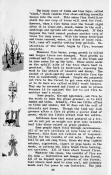 |
| 41 |
0040 |
of sawmill workers depend on an adequate
timber supply. When fire burns a forest, part of the source of their
livelihood is destroyed.
There are other enemies of the forest,
too. Cattle, sheep and hogs, when allowed to roam in the woods in
large numbers, destroy young seedlings by eating tender branches or
rooting them up. They also trample and pack the soil so it will not
absorb water. Then the forest floor becomes too dry. This shortage
of water even slows the growth of large trees which have their
foliage beyond the reach of livestock.
Insects and disease also attack trees.
Probably the disease most familiar to people in the Appalachian
region is the fungus called "Chestnut Blight." This disease attacks
the cambium layer of the tree, eating its way entirely around the
trunk. Then the tree dies. Older residents can remember when
chestnut trees comprised a large part of the hardwood stands of the
country. The gathering and roasting of chestnuts in the fall was a
popular event. In about 20 years, 1920 to 1940, the disease killed
nearly all chestnut trees in this area.
Except for isolated cases, no other
attacks by insects and fungi of epidemic proportions have occurred
in the Appalachian region. However, eternal vigilance is essential
to keep these pests out of the forests.
Weather sometimes can be a forest enemy,
too. Snow and ice bend or break branches and tree trunks. Hurricanes
sometimes even blow trees down. Lightning also strikes and kills
trees, but, except for fires which it starts, damage is usually
minor.
Ignorant and careless people who start
fires and allow them to burn are the forests' main enemy. Children
should learn now to take care of the forests and prevent fires from
occurring.
STUDY OF WORDS IN THE TEXT
NATURAL RESOURCE — one of the
necessities of life which nature gives to man.
FUNGUS — a plant which gets its food and
life from other plants.
CLEAR-CUT — removal of all trees from an
area.
EPIDEMIC — a condition in which many
trees are attacked by the same disease at the same time.
SELECTIVE CUTTING — removal of mature
timber, usually the oldest or largest trees, either as
41
|
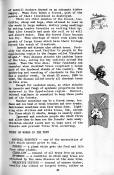 |
Chapter 10
page 42 |
0041 |
single scattered trees or in small
groups. These are removed at short intervals of 5 to 20 years.
Repeated again and again natural reproduction is encouraged and a
growing stand of timber of varying ages is maintained.
REVIEW QUESTIONS
1. Discuss the enemies of the forest.
Was it necessary to clear some land? Explain.
2. Why is it a bad thing to cut all
trees from the woods? Give three reasons.
3. How do most woods fires start?
4. Name five enemies of the forest. How
do they injure trees?
5. When does weather become an enemy of
the forest?
SOME THINGS TO DO AFTER STUDYING THIS
LESSON
1. Try to find two adjacent forest
areas: one in which all the trees were cut and one in which only
part of the trees were cut. Study the difference .
2. Find an area in the forest which has
been burned. See if the young trees and soil have been harmed. Find
out how the fire started.
3. Try to find two stands of timber: one
in which cattle have grazed and one in which they have not. Note the
difference.
Chapter Ten
FOREST GUARDIANS
Lumbermen are among the principal
guardians of America's vast forest resources. They see the need for
growing trees for use.
It is as impractical for landowners to
have individual organizations for protection against fire as it is
for home owners. Therefore, protection work against fire is done on
a basis of
42
|
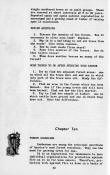 |
| 43 |
0042 |
cooperation, largely through private
individuals or organizations with state and federal governments.
Landowners through taxes and assessments pay the cost of these
government forest protection services. Private organizations,
supported by the landowners, also help in the forest fire control
programs.
To protect forests the fire control
agencies build towers from which lookouts locate and report fires.
They also organize fire crews, equip them with tools and teach them
how to fight and put out forest fires. The title, "State Forester,"
is usually given the man in charge of the state forest fire control
organization. His office is in the state capital. He usually has one
assistant to direct fire control work and another for forest
management. The state is divided into districts, each with a
forester in charge. Districts in turn are divided into fire control
units, with rangers in charge. Rangers usually are full-time
employees.
During fire season, local men volunteer
or are hired as fire fighters. When a fire occurs, they are ready to
get to it quickly and put it out. When not fighting fires they
maintain tools, roads, trails and telephone lines. An efficient,
well-manned, adequately-equipped and financed state-wide
organization provides better fire protection than is otherwise
possible.
Operators working on their own land also
may have cooperative agreements with the states. Besides furnishing
tools and equipment the state trains the landowners' employees to
quickly control fires when they occur. In recent years these state
forest protection organizations have made great progress.
Educational programs, designed to
prevent fires and control them more quickly, have done much to cut
down both the number and size of forest fires. The problem, however,
is not licked. All of us must be alert to hold the gains which have
been made. You can help by always being careful with fire and by
putting out small fires when they start.
Extension departments of state
agricultural colleges also have forestry programs. Most of their
work is with farmers. Their educational and demonstrational programs
encourage wise woods use. The U. S. Forest Service and the Soil
Conservation Service also are active in this work.
43
|
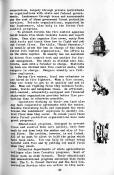 |
| 44 |
0043 |
In the Appalachian region many private
companies have their own forestry programs directed by professional
foresters. Good forest management is now a sound Investment on which
good returns can he expected. Both state and private foresters are
bringing their programs to the attention of landowners and others by
means of lectures, wood lot demonstrations and pictures.
Perhaps you would like to know how
forest fires are discovered and reported, and how men fight them?
Each state has a network of lookout
towers located on high ground. From these towers men watch for
rising smoke, always the first sign of a woods fire. "Permanent
smokes" caused by trains, factories or dwellings are spotted on the
towerman's map so he will not mistake them for forest fires. A
towerman learns to distinguish between smoke from a wild fire and
smoke from other sources. When smoke from a wild fire is spotted,
the towerman telephones a dispatcher in headquarters who telephones
the fire crew telling them where the fire is located and the
quickest way to get there. In some areas radios are used instead of
telephones.
As soon as a fire crew gets the message,
it rushes to the fire. There the leader puts his men to work in the
spot where the fire can most quickly be controlled. Then he looks
for evidence as to how the fire started, and who started it. If
necessary, criminal action may be brought against the individual
responsible.
The leader of the fire fighting crew
also sizes up the fire and determines whether he has enough men to
handle it. If not, he calls back to headquarters and requests
additional help. If his own crew can handle the fire, he also
reports that fact.
To halt the spread of a fire the control
crew plows or clears a ring around it, removing all inflammable
material. Crew members work their way through the burned area,
putting out fires in logs, brush or other material that might throw
sparks over the line. When all the fire has been extinguished inside
the ring a few men are left to guard it. The rest of the crew
returns to headquarters. There the leader checks all tools and
reorganizes his forces to handle another fire should one occur.
Later in the day he examines the fire and, if it is all out, brings
the rest
44
|
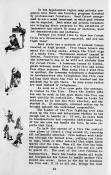 |
| 45 |
0044 |
STUDY OF WORDS IN THE TEXT
FOREST NURSERY — a place where forest
trees are raised from seed for planting in denuded areas which will
not seed naturally.
REFORESTATION — the act of planting
trees by hand. Where new trees grow up without man's help in
planting, it is called natural reforestation.
LOOKOUT TOWERS — steel or wooden towers
located on high ground from which people locate and report forest
fires.
RESEARCH — the carrying-out of
experiments to establish new facts, or prove existing theories.
REVIEW QUESTIONS
1. Name four organizations working in
forest conservation in your state.
2. Briefly describe the work of your
state forestry agency. Where are its offices?
3. Describe how forest fires are fought.
SOME THINGS TO DO AFTER STUDYING THIS
LESSON
1. Learn the name of your district
forester. Learn the name of your county ranger. Invite them to talk
to your class some day. Tell them you would like to see their trucks
and equipment.
2. Visit an area with the district
forester where timber has been marked for cutting. Find out how
marking is done.
Chapter Eleven
LOOKING TO THE FUTURE
The forestry program private enterprise
has established and now carries forward makes the outlook bright for
our future timber needs. The forest industries have adopted new
tools and methods. They are cutting timber for today's needs and
growing trees for tomorrow.
46
|
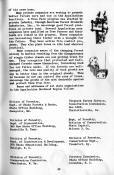 |
Chapter 11
page 46 |
0045 |
STUDY OF WORDS IN THE TEXT
FOREST NURSERY — a place where forest
trees are raised from seed for planting in denuded areas which will
not seed naturally.
REFORESTATION — the act of planting
trees by hand. Where new trees grow up without man's help in
planting, it is called natural reforestation.
LOOKOUT TOWERS — steel or wooden towers
located on high ground from which people locate and report forest
fires.
RESEARCH — the carrying-out of
experiments to establish new facts, or prove existing theories.
REVIEW QUESTIONS
1. Name four organizations working in
forest conservation in your state.
2. Briefly describe the work of your
state forestry agency. Where are its offices?
3. Describe how forest fires are fought.
SOME THINGS TO DO AFTER STUDYING THIS
LESSON
1. Learn the name of your district
forester. Learn the name of your county ranger. Invite them to talk
to your class some day. Tell them you would like to see their trucks
and equipment.
2. Visit an area with the district
forester where timber has been marked for cutting. Find out how
marking is done.
Chapter Eleven
LOOKING TO THE FUTURE
The forestry program private enterprise
has established and now carries forward makes the outlook bright for
our future timber needs. The forest industries have adopted new
tools and methods. They are cutting timber for today's needs and
growing trees for tomorrow.
46
|
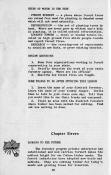 |
| 47 |
0046 |
Births and deaths of trees on old stands
of virgin timber occurred evenly. From year to year there was little
change in volume of wood in the forest. To the people of America it
seemed the supply of wood was endless. Timber was cheap. Only the
finest quality wood from the best species was salable. Forestry was
a little known science, and there was little incentive to use it in
the woods.
There is little opportunity to practice
forestry in a virgin stand. Large, over-mature trees must be removed
first to put the forest in proper shape for a forestry program to
begin. Trees in a second growth stand make rapid growth.
We have come to think of timber as a
crop. Trees now are harvested systematically, like other land crops.
Second-growth timber stands along with hundreds of new uses for wood
have completely changed the forest economy of the country. Today,
forests are more valuable, and forestry is more practical than ever
before. Most landowners and timber operators realize that cutting
small trees for lumber is a high cost operation. Small trees produce
low grade, low priced lumber
We have learned many things about
forestry that were unknown a generation ago. We know how to grow
trees, how to protect them and how to get the best wood harvest.
Research in the physical characteristics of wood has developed many
new uses, making forest products more valuable. Today there is more
incentive to grow trees. If.woodlands are managed wisely, the owners
can expect good returns from their trees.
One of the programs private industry
sponsors to encourage good forest practices in the United States is
the American Tree Farm System. A Tree Farm is a plot of ground on
which the owner grows, protects and harvests trees. Owners who
manage their woodlands wisely receive certificates. Most Tree Farms
are marked with signs. Today there are more than 2200 Tree Farms in
the United States. More are being established every year.
In 1930 about 300 foresters were
employed by private industry. Today, nearly 3,000 trained
leaders work for industry to protect the
nation's timberland.
Private industry recognizes the
importance of forests. It is prepared and able to protect to insure
America's future timber needs.
47
|
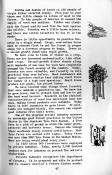 |
| Bibliography |
0047 |
BIBLIOGRAPHY
Publications of
American Forest Products Industries, Inc., 1319 Eighteenth St., N.
W., Washington 6, D. C.:
TREES FOR TOMORROW
THE STORY OF FORESTS (booklet and filmstrip)
CHARTS:
WHERE WE GROW OUR TREES
PRODUCTS OF AMERICAN FORESTS
WOOL, THE VERSATILE MATERIAL
FIRE POSTERS
National Lumber
Manufacturers Association, 1319 Eighteenth St., N. W., Washington 6,
D. C.:
OUR ABUNDANT FORESTS
AMERICA'S FOREST RESOURCES
Motion Pictures:
TREES FOR TOMORROW (American Forest Products Industries, Inc.
TIMBER GROWING TODAY (Tennessee Valley Authority, Dept. of
Forestry Relations, Norris, Tennessee)
THEN IT HAPPENED and IT'S NO PICNIC (U. S. Forest Service,
Bankers Securities Bldg., Philadelphia 7, Pennsylvania)
SOUTHERN HARDWOODS — YOURS FOREVER (Southern Hardwood
Producers, Inc., Sterick Bldg., Memphis, Tennessee)
|
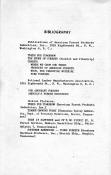 |
| |
|
|
|


